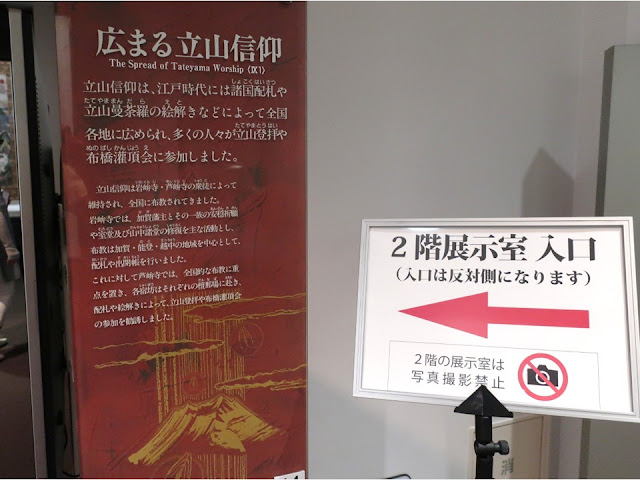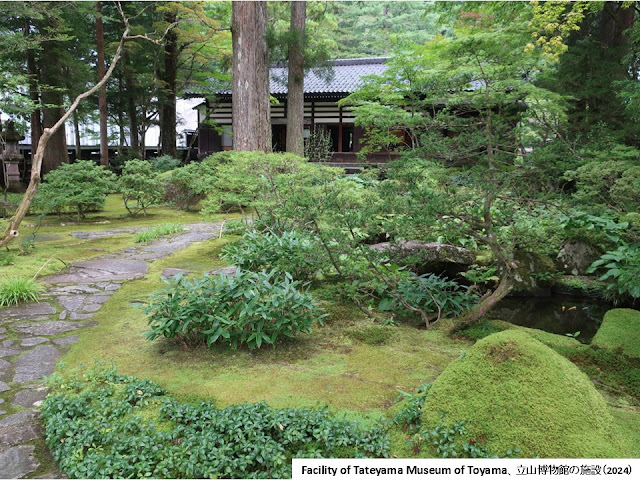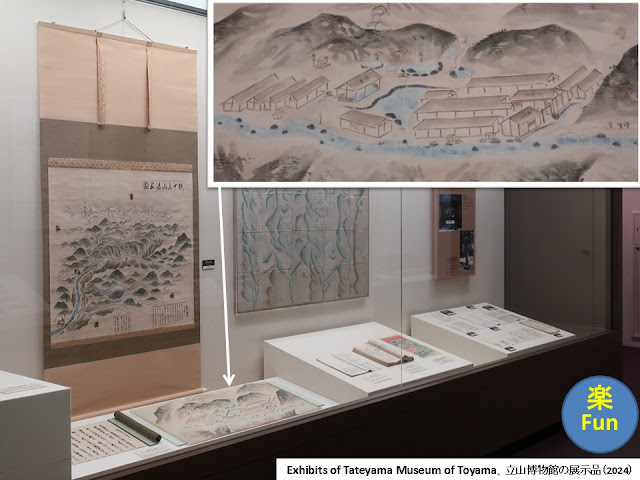Mt. Tateyama (3003 meters) exudes a certain dignity. It also provides water and so on to the residents. Locals have
worshipped the mountain, and have spread the faith across Japan.
In
the peaceful Edo period (1603~1868), the number of visitors
increased. They climbed the mountain, and prayed for rebirth
in paradise after their death. I reckon they also enjoyed the pilgrimage as
a trip. Btw, Mt. Tateyama is very popular tourist spot at present.
The museum shows us nature and worship of the mountain. I recommend to visit a shrine and former pilgrims' lodgings
near the museum, which imagine us the old time. I divided this article into
fife chapters below.
1.About Mt. Tateyama、立山という山 (this article)
2.Beginning of the faith、信仰の始まり (this article)
3.Promotional
efforts of the faith、信仰を広げた仕掛け (this article)
4.Mt.
Tateyama worship by ordinary people、庶民の立山登拝 (next article)
5.Mountain
climbing in the modern era、剱岳に登ってしまった近代人 (next article)
富山市街から見える立山は高く聳える神々しい山です。そして水をもたらしてくれる恵の山でもあります。人々は立山に神を感じ、手を合わせ、信仰を広げました。
戦国の世が終わり平和で豊かになった江戸時代には立山登拝を目指す人が増えました。人々は立山に登り死後の往生を願いながらも、旅(巡礼先)として現世を楽しんだと思います。そして、今は大人気観光地です。
博物館では自然と信仰の両面から立山が紹介されています。また、博物館近くの宿坊や神社では、往時の信仰を実感できます。上の五つのパートで紹介します。
It is a huge prefectural museum. Its office administrates facilities such as ex-lodgings in the area well.
県立の大きな博物館です。旧宿坊など一帯の施設も博物館がしっかりと運営管理しています。
1.About Mt. Tateyama、立山という山
Mt. Tateyama’s nature is exhibited in the exhibition room on the 3rd floor. The mountain is special because it has been respected and has been worshipped since the ancient era. You can take photos freely on the 3rd floor.
3階は「立山信仰の舞台」という展示室です。人々に畏怖され、信仰の対象になった立山の自然が紹介されています。3階の写真撮影は申請不要です。
The elaborate model is displayed (above). The divine shape of mountains awakened the people’s faith. The forest reserves water like a huge dam, and supplies water to people in the Toyama Plain.
People have climbed Mt. Tateyama (3003 meters) and have prayed for rebirth in paradise. On the other hand, it was prohibited to climb Mt. Tsurugidake (2999 meters), which was an extremely sacred place.
ジオラマが展示されています(上)。立山の森は水を貯める大きなダムで、富山平野に水の恵みをもたらしました。また、山の雄姿は人々の信仰心を起こしました。
立山の雄山(3003m)は極楽往生をするために登拝する山、一方、剱岳(2999m)は登ってはならない山でした。
People thought of Murodo-daira (flatland) in front of the Tateyama Mountain Range as a paradise (gokuraku). Mikurigaike above is a volcanic lake.
立山の前に広がる室堂平を人々は「極楽」としました。美しいところです。写真はみくりが池と立山連峰。
The mountain hut “Murodo” above is the oldest one in Japan, which was rebuilt in 1726. It is the origine of the name “Murodo-daira”; “muro” means a lodging and “do” means a religious hall, so it had double functions. The photo on the upper right shows inside the building.
室堂平の名の由来となった日本最古の山小屋「室堂」(1726年再建、国重要文化財)が残っています。「室」は宿泊所、「堂」は宗教施設を示します。右上は案内板に載っていた建物の内部です。
There is Hell Valley under the Murodo-daira. Sulphur colored it yellow and gray, and prevents creature from living. People have thought of it as a hell.
The peat bog looks like a rice field because there is grass on it. Hungry ghosts wait the rice growing; but it never occurs. So, they suffer from hunger. Not only the paradise but also the hell are there.
立山の直下には、硫黄が噴き出し黄色と灰色に染まった谷があります。生物がいない谷です。人々はここを地獄と見立ててきました(上)。
更に下ると草が生え、田のようですが米はできない池があります。腹をすかせた餓鬼が米ができるのを待って苦しみ続ける「餓鬼の田んぼ」と呼ばれました。立山には地獄もあります。
The theme of the exhibition room on the 2nd floor is “The world of Tateyama Worship”. In order to take photos, it is required to get a permission. And, it is required to submit an application to upload them on a website.
2階は立山信仰をテーマにした展示室です。撮影をするためには申請が必要で、ウエブなどで公開するためには許可が必要です。
2.Beginning of the faith、信仰のはじまり
There is a legend in 701. A man chased his white hawk and climbed Mt. Tateyama. He encountered a bear and shot an arrow; he went to a cave where the bear hid. He found two Buddhist statues. One was Amida Buddha hit by the arrow, and another was Acala (deity of fire). It meant the bear was Amida Buddha, and the hawk was Acala.
After the spiritual experience, he regretted and founded a religious facility on the mountain. The model above is the cave. The photo of the actual one is at the upper left, which is named “Tamado no Iwaya”.
701年に飼っていた白鷹を追った男が立山に入りました。男は途中で熊を射て、熊が逃げ込んだ洞窟に入ったところ、そこには矢が刺さった阿弥陀如来と不動明王がいました。熊は阿弥陀如来の化身であり、白鷹は不動明王の化身だったのです(開山縁起などによる)。
男(佐伯有若あるいはその子の有頼、のちの慈興上人)は霊異を得て立山を仏の山として開きました。洞窟の模型が展示されています。(左上は実際の洞窟。「玉殿の岩屋」と呼ばれています。)
After the mid-Heian period (794-1185), the perception about hell had spread; people started thinking that they suffered if they went to hell after death. In Buddhism, Enma (the King of Hell) gives a decision whether a person go to hell or paradise. Mt. Tateyama had been famous for the mountain which had a hell even in the capital back then (Kyoto).
末法思想が流行した平安中期以降、死後の苦しみの世界・地獄の認識が広がりました。立山は地獄がある山として都にも知れわたったのです。
3.The system to spread the faith、信仰を広げた仕掛け
The people who had spread the faith had preached that the religious mountaineering to Mt. Tateyama ensured to go heaven after death. In addition, people could see the hell there. Even in the Edo period (1603~1868) when people traveled on foot, six thousand visitors climbed the mountain at the peak time. The guide maps are displayed on the left.
立山信仰を広めた人たちは、立山に登れば極楽往生をできる、また、立山では地獄を見られると説きました。徒歩しか手段がなかった江戸時代でも、最盛期には6000人が登りました。案内図(左側)が残っています。
Visitors stayed at pilgrims' lodgings (syukubo) in Ashikura-ji area or Iwakura-ji area. The term of their tour to Mt. Tateyama was two or three days. A staff of a lodging guided visitors to Murodo; thereafter a monk did them to Tateyama mountains and Hell Valley.
The monks and staff of lodgings were so busy in summer and in autumn equinoctial week (lower right). A lodging (syukubo) is not only an inn, but also a temple dedicated to Amida Buddha and Acala, and a dwelling of monks and staff.
立山に来た男たちは登拝拠点である芦峅寺地区か岩峅寺地区の宿坊に泊まり、三泊二日、あるいは四泊三日の行程で出発しました。室堂までは中語と呼ばれるガイドが案内し、室堂では宿坊衆徒が立山三山巡りや地獄谷巡りに案内しました。
参拝者が多い夏や秋の彼岸は、宿坊は大忙し(右下)。宿坊は宿であり、阿弥陀如来・不動明王を祀る寺であり、衆徒が住む住居でした。
The former pilgrims’ lodging “Kyousan-bou” remains by the museum (on the left). There were thirty-three lodgings along the street. I went through the gate of the lodging (upper right).
博物館の隣にかつての宿坊「教算坊」が残っています(左側)。かつては、前の通りに33の宿坊が並んでいました。教算坊の門(右上)をくぐります。
There is a beautiful strolling garden with a pond inside the gate. The main building is in behind.
美しい池泉回遊式庭園がひろがり、その向こうに主屋があります。
A large hanging picture scroll is displayed in the inner room of the main building.
主屋の奥には絵が飾られています。
The scroll is named “Tateyama mandala”, which shows us the establishment and the benefit of the faith of Tateyama.
The religious mountaineering to Mt. Tateyama will make men be reborn in the heaven (gokuraku) after their death (upper left). However, we will go to the Enma’s court at first after death and will be convicted (in the middle). Women will have a chance to be reborn in the heaven by attending the purification ceremony (lower left).
絵は立山曼荼羅と呼ばれる四幅一対のもので、立山の開山由来と功徳が描かれています。
登拝によって極楽往生できるということ(左上)、死んだら閻魔様に裁かれるということ(左中)、女性は布橋灌頂会という法会によって救われるということ(左下)が示されています。
Monks of lodging took care of worshippers (visitors). On top of that, they went to area in charge in winter (off-season) and explained the meaning of the Tateyama mandara at a worshipper’s residence. They elaborated the benefit of the religious mountaineering and invited people to Tateyama. The doll in the museum. above explains like them
宿坊の衆徒たちは宿坊で信者をもてなすだけでなく、閑期の冬に担当地域に出かけて世話役(檀那・檀家、庄屋など)の家で絵解き説法をしました。立山曼荼羅を前に、地獄の恐ろしさと立山登拝による救済を語りました。博物館では模型が展示され、解説をしてくれます。なお、衆徒たちは他の社寺と同じく、御師と呼ばれていました。
https://www.youtube.com/watch?v=0kRa4hNUjm8&t=4s
Monks delivered goods on the right while visiting area in charge in missionary work. Those are talismans, medical herbs grown in Tateyama, and burial clothes. They also brought the statues on the left (Yakizu(arrow wound) Statue of Amida Budda). There were many matters beyond control back then. The worshipping Tateyama helped many people, I guess.
衆徒たちは布教の際に、死装束やお札、更には立山山中特産の薬品(薬草)を配りました。また、出開帳も行いました。左はその時に持参した矢の傷を負った阿弥陀如来像です。どうにもできないことが多かった封建時代の人々は立山信仰によって救われたと思います。
Believers were entertained in lodging. The panel above shows a feast served by a lodging, which included sake (alcohol).
宿坊の接待:先ほど紹介した教算坊では檀家の接待の再現写真が展示されています。精進料理ですがお酒も出され実に豪華です。
The models of dishes are displayed. It is said you can eat it at Mandara-shokudou (restaurant) nearby if you make a reservation. Red tableware was used for believers and black one was done for visitors from the areas which were not in charge.
檀家に出したお膳の模型が展示されています。立山芦峅ふるさと交流館の食堂で食べられるそうです(要予約)。檀家には赤御膳で、宿坊の担当地区外の人(参連衆)には黒御膳で出されました。
Nunobashi Kanjoe Purification Ceremony、布橋灌頂会
As a matter of fact, women were prohibited to climb Mt. Tateyama, which was not a strange custom back then. Monks recommended women to participate in the ceremony in stead of climbing Mt. Tateyama, because women could avoid going to hell and could go to heaven by attending the ceremony.
実は、立山は女人禁制の山でした。衆徒たちは、登拝を許されない女性は布橋灌頂会に参加することで、地獄行きを免れ極楽往生をできると説きました。
In the ceremony, women put on burial clothes (white color). They go to Enma Hall at first and confess their sins at first. Then they put on blindfold, walk on the long white cloth, and cross the Nuno (cloth) -bashi (bridge). If a woman does bad things, she feels that the cloth is narrow. The river is considered as the Sanzu River which is a boundary of this world and another world.
There was Uba (old women) hall on the opposite side of the river; there were sixty-nine Uba statues. They pray there; the behavior is same as a religious mountaineering to Mt. Tateyama.
布橋灌頂会では、女性たちは死装束をまとい、閻魔堂(この世)で懺悔をし、目隠しをして敷かれた布の上を歩いて布橋に向かいます。悪事が多い人は布が狭く感じるそうです。橋の下は三途の川と見立てられています。
布橋の対岸にはうば堂(あの世)があり、69躰ものうば尊が祀られていて、お参りすれば立山に登ったのと同じ功徳が得られます。
Remaining Uba statues are exhibited in the museum. Although those are a bit scary, locals love the statues.
Regrettably enough, the Uba Hall was broken and the statues were scattered in the beginning of the Meiji period (1868-1912) because of the movement to abolish Buddhism. Ten statues remain in the area now. The one at lower right was probably made in 1375.
ちょっと怖い見た目ですが、うば尊像が展示されています。地元の人には「おんばさま」と親しまれているそうです。
残念なことに廃仏毀釈でうば堂は破壊され、うば尊像は四散してしまいましたが、10躰が芦峅寺に現存しています。右下は1375年の銘があるうば尊像です。
It never is tolerated, but it was considered that women had impurity (mudblood) due to menstruation back then. Therefore, it was said that women were destined to go to hell. However, they could escape from their destiny and could be reborn as man by attending the ceremony and getting the talisman above.
Although the ceremony was not held for more than 130 years, it has been done since 1996.
今ではとんでもない話ですが、当時は女性は血(生理)の穢れがあるとされて、死後は地獄に行くとされていました。しかし、法会でいただける「血脈」の護符によって、死後は男性に生まれ変わり極楽往生できるとされました。
布橋灌頂会は130年余り途絶えていましたが復活し、今は三年に一度、秋の彼岸の中日に行われています。
Enma Hall, which is the starting point of the ceremony, was also broken by the movement in the beginning of the modern era. However, the hall was rebuilt in 1937 using the woods which were parts of the ex-hall. Locals sincerely kept the parts, didn’t they? Enma and Uba are enshrined in the hall.
法会の出発場所・閻魔堂も廃仏毀釈で壊されましたが、1937年にかつてのお堂の部材を使って再建されました。部材が大切に保管されていたのですね。堂内には閻魔様とおんばさまが祀られています。
I downed the stairs in front of the hall and went to the bridge. It is risky to go down wearing blindfold, although stone Buddhist statues along the steps watch over us.
お堂の前の階段を下りて布橋へ向かいます。目隠ししておりるのは怖いですが、道端で多くの石仏が見守ってくれます。
The bridge (Nuno-bashi) was built again in 1970. There is a graveyard beyond the bridge since around seven hundred years before. It’s the other world.
布橋は1970年に復元されました。橋の向こうは約700年も前から墓域です。あの世ですね。
There is Uba Hall ruin behind the graveyard. Participants in the ceremony prayed in the hall, crossed the bridge again, and returned to this world. Unfortunately, I couldn’t see Mt. Tateyama when I visited.
https://www.youtube.com/watch?v=TuKq5sLUSVI
墓地の先にうば堂の跡があります。ここで法会の参加者は救済され、橋を渡ってこの世へと戻ります。残念ながら訪問日は立山を見られませんでした。
Hot spring、温泉
It was probably great fun for religious climbers to soak in a hot-spring after climbing. There was a hot-spring resort on the way to Mt. Tateyama. The picture shows facility for visitors. Yakushi-nyorai (govern the health) statue was enshrined. Unfortunately, the hot-spring resort was destroyed by the earthquake in the mid-19th century. There is a hot-spring for construction workers nearby, but it is not open to the public.
男性の参拝者には宿坊での楽しみだけでなく、温泉の楽しみもありました。立山への登拝路には立山温泉があり、湯治客小屋が立ち並ぶ絵図が残っています。薬師如来様が祀られていますね。登拝を終えて温泉、たまりません。
温泉街は江戸末期の地震で壊滅してしまいました。今は少し離れた場所に砂防工事関係者用の温泉があるそうですが、一般客は利用できません。
There were people who took roll of protecting Tateyama’s natural environment. The leader’s (Ukita’s) residence in Toyama city is open to the public. They managed the forest and guarded the border of the territory. Mt. Tateyama had been preserved due to their efforts.
江戸時代に立山の自然を守った人たちがいます。黒部奥山廻りの人々です。1693年から山林取り締まりと国境警備を務めた浮田家の屋敷が富山市内にあり公開されています。彼らがいたから信仰の山としての立山が守られたのですね。
Official website: https://tatehaku.jp/ (in Japanese), accessed in
March, 2025
Visited in September, 2024
Previous post (museum in the same prefecture): Toyama
Municipal Folk Museum、富山市郷土博物館
Next post (part2 of this article): Tateyama Museum of Toyama and Mt. Tateyama (2/2) 、立山博物館と立山 (part2)





























Comments
Post a Comment